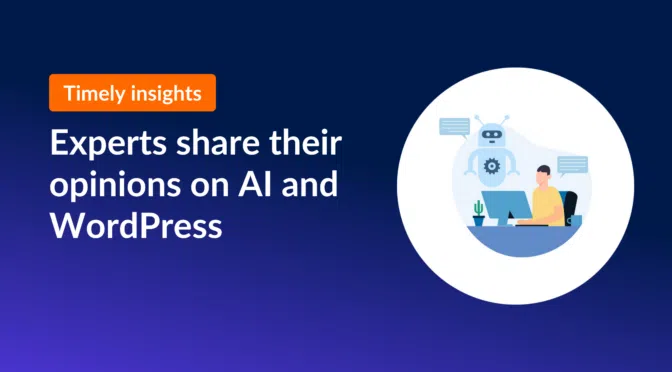AI is no longer on the horizon—it’s here, reshaping how we build and interact with the web. From copywriting assistance to full-on site generation with a single prompt, the tools we use, and the ways we use them, are evolving fast.
In fact, WordPress.com recently launched an early access version of their Big Sky AI website builder, demonstrating their committment in bringing AI tools to the WordPress world. But what does all this mean for you? And what should you do to keep up?
I reached out to renowned WordPress advocates to understand how industry experts are navigating the rise of AI—and what it means for the future of WordPress.
Are WordPress builders embracing AI?
We recently surveyed over 100 WordPress users—including agency owners, developers, freelancers, hobbyists, and site managers—about how often they use AI in their workflows. The results, shown in the chart below, reveal a fairly even split across “Rarely,” “Sometimes,” and “Often,” with fewer respondents landing at the extremes of “Never” or “Always.”
Live chart pulling data from a Gravity Forms survey form. Created using GravityCharts.
The balanced distribution suggests that while AI use is widespread, it’s not yet habitual for many WordPress users. Users are dabbling or experimenting, but few have fully integrated it into their daily workflow.
Based on these results, I believe we’re currently in the exploration phase of AI adoption in WordPress, where the tools are still finding their place. Over time it will become clear where they are most impactful—whether for prototyping, automation, brainstorming, designing, coding, copywriting, or all of the above!
So should you wait to suss things out, or start embracing AI tools now so you can stay ahead of the game?
How to approach AI as a WordPress user
It’s no secret that AI tools are starting to change the way we build websites. With the rise of “vibe coding” using tools like Lovable.dev and Bolt.new, anyone can create a fully functioning website or app using a simple text prompt.
But what does this mean for the WordPress ecosystem and how should you approach these new tools? Product creator, Tammie Lister, recommends “playful experimentation”.
One of the most important things to learn, in my opinion, is experimentation with new tools. Learn to use different AI editors, not for production-ready perfection, but as prototyping tools—like rubber ducks for brainstorming. Embrace playful experimentation, pushing the boundaries of what’s possible and discovering limitations. This process might uncover new challenges or even lead to solutions that benefit everyone. We’re all learning together, in a sense, playing and exploring thanks to the rapid advancements we’ve seen recently. It’s time to embrace this playful exploration in our work.

Tammie Lister
Product creator and WordPress core contributor
In a recent video, WordPress YouTuber Jamie Marsland demonstrates building a headless WordPress site using AI to write the code. “Part of my brain is thinking this could definitely be one future of WordPress, not for every website obviously, but for certain websites”, he says.
Jamie’s vision involves using WordPress as a content management system and leveraging its extensive plugin ecosystem, while using AI design tools to create visually stunning front-ends.
However, while AI excels at designing stunning web pages, it falls short when it comes to understanding the content of the web. This is what WordPress leader Joost De Valk points out in a recent blog post, reminding us that overly-complex, JavaScript-heavy websites are essentially invisible to AI and sometimes even search engines.
“You can have the most beautifully designed website in your favorite JavaScript framework, but if the HTML that comes out of it is garbage and your content is buried behind five layers of client-side rendering… you’re invisible. To AI. Often even to Google. And thus: to users.”
With AI tools capturing a growing share of search traffic, building a site that can’t be effectively crawled by LLMs can severely impact your SEO and online visibility. The key takeaway? Absolutely, embrace AI to streamline your workflow—but don’t lose sight of the user in the process!
The potential of AI in shaping WordPress services and product development
To better understand the impact of AI on web agencies and product companies, I turned to WordPress expert and founder of The WP Minute, Matt Medeiros. While Matt sees real potential for AI to enhance both services and products, he advises against rushing into feature development—emphasizing that the real priority should be creating better user experiences.
In the emerging world of AI, I think it’s important to stay level-headed as a service or product company to find a balance. Don’t rush to add AI features that will quickly be rolled into native AI experiences, but also look for the opportunity to improve your customer’s experience. I think there’s a new window of opportunity to leverage both WordPress and AI in ways that can increase revenue for services agencies, beyond helping you build themes or plugins faster.

Matt Medeiros
Community at Gravity Forms; Leader in WordPress & podcasting
Zack Katz, veteran WordPress developer and founder of GravityKit, emphasizes the importance of ensuring quality output when utilizing AI in product development. As AI continues to transform our workflows, maintaining high standards and a sharp focus on quality is more important than ever.
*Opens ChatGPT*Write a quote about how at GravityKit, we're using AI as an accelerant to unlock productivity. When AI is involved, you need to pay more attention to code quality, security, and accessibility. We’re finding that using AI has already resulted in faster idea-to-launch schedules.
At GravityKit, we’re using AI as an accelerant to unlock productivity and move from idea to launch faster than ever. But speed doesn’t come at the cost of standards: when AI is in the mix, we’re doubling down on code quality, security, and accessibility. It’s not just about working faster; it’s about building better.

Zack Katz
Founder and CEO of GravityKit
In summary: What AI means for WordPress
AI isn’t replacing WordPress—it’s expanding what’s possible within it.
Whether you’re a freelancer, agency owner, developer, or just experimenting with side projects, it’s clear we’re at the start of something big. The tools are rapidly evolving, the workflows are shifting, and the builders (people like you) are figuring it out in real time.
The message from the experts is consistent: don’t wait for perfect AI tools to show up. Start playing. Start prototyping. Start learning. Not everything will stick—but the skills and instincts you develop now will be invaluable as these tools mature and become more deeply embedded in our workflows.
As AI accelerates what’s possible, it’s easy to prioritize speed or novelty. However, the real opportunity lies in combining the efficiency of AI with the thoughtful, high-quality work that sets great builders apart.
Amid all the innovation, remember what makes WordPress powerful in the first place: its content-first philosophy, its flexibility, and its community. AI can enhance that, but it can’t replace the human insight behind great experiences.

Helpful tips right in your inbox.
Subscribe to our weekly newsletter for tips, special offers, and more!
Helpful tips right in your inbox.
Subscribe to our weekly newsletter for tips, special offers, and more!
